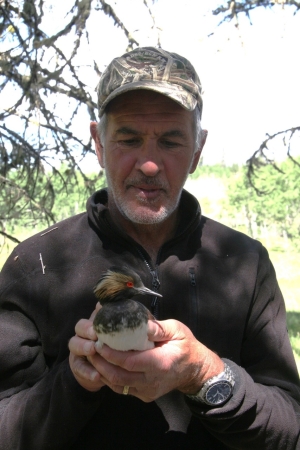Research Scientist
Science & Technology Branch, Environment and Climate Change Canada, Pacific Wildlife Research Centre
Bio:
Dr. Sean Boyd started his professional career as a habitat biologist with the Canadian Wildlife Service of Environment Canada in 1980. He completed his PhD in 1995, became a Research Scientist in 1997, an Adjunct Professor in the Biology Dept. of Simon Fraser University in 1998, and he continues to serve on advisory committees of graduate students affiliated with SFU and the University of BC. Sean has worked on a variety of migratory bird projects, including the winter ecology and demographics of Snow Geese, population demographics and migration behavior of Brant Geese, Harlequin Ducks, Barrow’s Goldeneye, Scoters, and Eared Grebes, at-sea foraging distributions of Cassin’s Auklets, and the ecology/status of Fraser River estuary tidal marshes. Many of his projects are long-term in nature and many involve the use of VHF and satellite telemetry to study migration and connectivity patterns.
Title: Abundance, Distribution, and Migration Patterns of NA Eared Grebes (Podiceps nigricollis)
Abstract: Almost all NA Eared Grebes (Podiceps nigricollis) undertake a post-breeding migration to molt and/or stage at two hypersaline lakes in the USA: Mono Lake, CA and Great Salt Lake, UT. We conducted air-photo surveys from 1996 to 2012 to estimate the number of grebes on Mono Lake in mid-October when peak abundance was assumed to be stable. However, because the surveys showed some unlikely changes across years, we decided to conduct multiple surveys each year starting in 2013 to assess differences in the timing of peak abundance. The peak in 2013 occurred in mid-October, as anticipated. However, peak abundances in both 2014 and 2015 occurred in mid-September followed by early mass departures from the lake. We speculate that unusually low shrimp densities may have caused the early departures and, as a result, many grebes moved to Great Salt Lake to molt and/or stage. Alternatively, there may have been a huge die-off in the Sea of Cortez, Mexico due to a very strong El Niño event in 2014-15, similar to 1997-98. To investigate if the fall connection patterns from British Columbia to Mono Lake and Great Salt Lake changed, we repeated a 1996 VHF telemetry study in 2017 and deployed light-level geolocator (GLS) tags on breeding birds in 2017 and 2018. The resulting data showed that affiliation patterns have indeed changed; in stark contrast to the late 1990s, most grebes in 2017 and 2018 molted and/or staged on Great Salt Lake and most overwintered in the Sea of Cortez. Finally, our multiple surveys since 2013 indicate that peak numbers on Mono Lake have increased but still have a long way to go to reach levels recorded in the late 1990s.

